Smart Electric Vehicle Charging via Adjustable Real-Time Charging Rates
Abstract
:1. Introduction
2. Materials and Methods
2.1. Problem Formulation
2.2. Transformer Data
2.3. PEV Data
3. Results and Discussion
4. Conclusions
Author Contributions
Funding
Institutional Review Board Statement
Informed Consent Statement
Data Availability Statement
Conflicts of Interest
References
- Torres-Moreno, J.L.; Gimenez-Fernandez, A.; Perez-Garcia, M.; Rodriguez, F. Energy Management Strategy for Micro-Grids with PV-Battery Systems and Electric Vehicles. Energies 2018, 11, 522. [Google Scholar] [CrossRef] [Green Version]
- Faddel, S.; Al-Awami, A.T.; Mohammed, O.A. Charge Control and Operation of Electric Vehicles in Power Grids: A Review. Energies 2018, 11, 701. [Google Scholar] [CrossRef] [Green Version]
- Kongjeen, Y.; Bhumkittipich, K. Impact of Plug-in Electric Vehicles Integrated into Power Distribution System Based on Voltage-Dependent Power Flow Analysis. Energies 2018, 11, 1571. [Google Scholar] [CrossRef] [Green Version]
- Xiong, R.; Sharkh, S.M.; Zhang, X. Research Progress on Electric and Intelligent Vehicles. Energies 2018, 11, 1762. [Google Scholar] [CrossRef] [Green Version]
- ZEV Action Plan. Available online: http://www.business.ca.gov/ZEV-Action-Plan (accessed on 14 October 2019).
- Zhu, J.; Yang, Z.; Mourshed, M.; Guo, Y.; Zhou, Y.; Chang, Y.; Wei, Y.; Feng, S. Electric Vehicle Charging Load Forecasting: A Comparative Study of Deep Learning Approaches. Energies 2019, 12, 2692. [Google Scholar] [CrossRef] [Green Version]
- Maps and Data—U.S. Plug-in Electric Vehicle Sales by Model. Alternative Fuels Data Center. Available online: https://afdc.energy.gov/data/10567 (accessed on 14 October 2021).
- Advanced Technology Vehicle Sales Dashboard. Alliance of Automobile Manufacturers. Available online: https://autoalliance.org/energy-environment/advanced-technology-vehicle-sales-dashboard/ (accessed on 14 October 2021).
- Van Triel, F.; Lipman, T.E. Modeling the Future California Electricity Grid and Renewable Energy Integration with Electric Vehicles. Energies 2020, 13, 5277. [Google Scholar] [CrossRef]
- Beil, I.; Hiskens, I. Coordinated PEV charging and its effect on distribution system dynamics. In Proceedings of the 2014 Power Systems Computation Conference, Wroclaw, Poland, 18–22 August 2014; pp. 1–7. [Google Scholar]
- Masoum, A.S.; Deilami, S.; Moses, P.S.; Masoum, M.A.S.; Abu-Siada, A. Smart load management of plug-in electric vehicles in distribution and residential networks with charging stations for peak shaving and loss minimisation considering voltage regulation. IET Gener. Transm. Distrib. 2011, 5, 877–888. [Google Scholar] [CrossRef]
- Sharma, I.; Cañizares, C.; Bhattacharya, K. Smart Charging of PEVs Penetrating Into Residential Distribution Systems. IEEE Trans. Smart Grid 2014, 5, 1196–1209. [Google Scholar] [CrossRef]
- Han, J.; Park, J.; Lee, K. Optimal Scheduling for Electric Vehicle Charging under Variable Maximum Charging Power. Energies 2017, 10, 933. [Google Scholar] [CrossRef]
- Milas, N.; Mourtzis, D.; Tatakis, E. A Decision-Making Framework for the Smart Charging of Electric Vehicles Considering the Priorities of the Driver. Energies 2020, 13, 6120. [Google Scholar] [CrossRef]
- Razeghi, G.; Zhang, L.; Brown, T.; Samuelsen, S. Impacts of plug-in hybrid electric vehicles on a residential transformer using stochastic and empirical analysis. J. Power Sources 2014, 252, 277–285. [Google Scholar] [CrossRef]
- Zweistra, M.; Janssen, S.; Geerts, F. Large Scale Smart Charging of Electric Vehicles in Practice. Energies 2020, 13, 298. [Google Scholar] [CrossRef] [Green Version]
- Gong, Q.; Midlam-Mohler, S.; Marano, V.; Rizzoni, G. Study of PEV Charging on Residential Distribution Transformer Life. IEEE Trans. Smart Grid 2012, 3, 404–412. [Google Scholar] [CrossRef]
- Wang, B.; Liu, W.; Wang, M.; Shen, W. Research on Bidding Mechanism for Power Grid with Electric Vehicles Based on Smart Contract Technology. Energies 2020, 13, 390. [Google Scholar] [CrossRef] [Green Version]
- Zhang, L.; Jabbari, F.; Brown, T.; Samuelsen, S. Coordinating plug-in electric vehicle charging with electric grid: Valley filling and target load following. J. Power Sources 2014, 267, 584–597. [Google Scholar] [CrossRef]
- Li, W.; Lin, Z.; Cai, K.; Zhou, H.; Yan, G. Multi-Objective Optimal Charging Control of Plug-In Hybrid Electric Vehicles in Power Distribution Systems. Energies 2019, 12, 2563. [Google Scholar] [CrossRef] [Green Version]
- Smith, T.; Garcia, J.; Washington, G. Electric Vehicle Charging via Machine-Learning Pattern Recognition. J. Energy Eng. 2021, 147, 04021035. [Google Scholar] [CrossRef]
- Smith, T.F.L. Continuously Varying Valley Filling Smart Charging Techniques, UC Irvine. 2019. Available online: https://escholarship.org/uc/item/5tq7k0q2 (accessed on 16 April 2020).
- Smith, T. Variable Rate PEV Charging Using Machine Learning and Optimization Techniques, UC Irvine. 2020. Available online: https://escholarship.org/uc/item/01g0x0ds (accessed on 25 October 2021).
- Khan, S.U.; Mehmood, K.K.; Haider, Z.M.; Rafique, M.K.; Kim, C.-H. A Bi-Level EV Aggregator Coordination Scheme for Load Variance Minimization with Renewable Energy Penetration Adaptability. Energies 2018, 11, 2809. [Google Scholar] [CrossRef] [Green Version]
- Tan, K.M.; Ramachandaramurthy, V.K.; Yong, J.Y.; Padmanaban, S.; Mihet-Popa, L.; Blaabjerg, F. Minimization of Load Variance in Power Grids—Investigation on Optimal Vehicle-to-Grid Scheduling. Energies 2017, 10, 1880. [Google Scholar] [CrossRef] [Green Version]
- Gan, L.; Topcu, U.; Low, S.H. Optimal decentralized protocol for electric vehicle charging. IEEE Trans. Power Syst. 2013, 28, 940–951. [Google Scholar] [CrossRef] [Green Version]
- Bao, Y.; Luo, Y.; Zhang, W.; Huang, M.; Wang, L.Y.; Jiang, J. A Bi-Level Optimization Approach to Charging Load Regulation of Electric Vehicle Fast Charging Stations Based on a Battery Energy Storage System. Energies 2018, 11, 229. [Google Scholar] [CrossRef] [Green Version]
- Moeini-Aghtaie, M.; Abbaspour, A.; Fotuhi-Firuzabad, M.; Dehghanian, P. PHEVs centralized/decentralized charging control mechanisms: Requirements and impacts. In Proceedings of the 2013 North American Power Symposium (NAPS), Manhattan, KS, USA, 22–24 September 2013; pp. 1–6. [Google Scholar]
- Kristoffersen, T.K.; Capion, K.; Meibom, P. Optimal charging of electric drive vehicles in a market environment. Appl. Energy 2011, 88, 1940–1948. [Google Scholar] [CrossRef]
- Clement-Nyns, K.; Haesen, E.; Driesen, J. The Impact of Charging Plug-In Hybrid Electric Vehicles on a Residential Distribution Grid. IEEE Trans. Power Syst. 2010, 25, 371–380. [Google Scholar] [CrossRef] [Green Version]
- Clement, K.; Haesen, E.; Driesen, J. Coordinated charging of multiple plug-in hybrid electric vehicles in residential distribution grids. In Proceedings of the 2009 IEEE/PES Power Systems Conference and Exposition, Seattle, WA, USA, 15–18 March 2009; pp. 1–7. [Google Scholar]
- Sortomme, E.; Hindi, M.M.; MacPherson, S.D.J.; Venkata, S.S. Coordinated Charging of Plug-In Hybrid Electric Vehicles to Minimize Distribution System Losses. IEEE Trans. Smart Grid 2011, 2, 198–205. [Google Scholar] [CrossRef]
- Ahn, C.; Li, C.-T.; Peng, H. Decentralized charging algorithm for electrified vehicles connected to smart grid. In Proceedings of the 2011 American Control Conference, San Francisco, CA, USA, 29 June–1 July 2011; pp. 3924–3929. [Google Scholar]
- Vayá, M.G.; Andersson, G. Centralized and decentralized approaches to smart charging of plug-in Vehicles. In Proceedings of the 2012 IEEE Power and Energy Society General Meeting, San Diego, CA, USA, 22–26 July 2012; pp. 1–8. [Google Scholar]
- Masoum, A.S.; Deilami, S.; Abu-Siada, A.; Masoum, M.A.S. Fuzzy Approach for Online Coordination of Plug-In Electric Vehicle Charging in Smart Grid. IEEE Trans. Sustain. Energy 2015, 6, 1112–1121. [Google Scholar] [CrossRef] [Green Version]
- Su, S.; Li, H.; Gao, D.W. Optimal Planning of Charging for Plug-In Electric Vehicles Focusing on Users’ Benefits. Energies 2017, 10, 952. [Google Scholar] [CrossRef] [Green Version]
- Hajforoosh, S.; Masoum, M.A.S.; Islam, S.M. Real-time charging coordination of plug-in electric vehicles based on hybrid fuzzy discrete particle swarm optimization. Electr. Power Syst. Res. 2015, 128, 19–29. [Google Scholar] [CrossRef]
- Singh, M.; Thirugnanam, K.; Kumar, P.; Kar, I. Real-Time Coordination of Electric Vehicles to Support the Grid at the Distribution Substation Level. IEEE Syst. J. 2015, 9, 1000–1010. [Google Scholar] [CrossRef]
- Bishop, J.D.K.; Axon, C.J.; Bonilla, D.; Tran, M.; Banister, D.; McCulloch, M.D. Evaluating the impact of V2G services on the degradation of batteries in PHEV and EV. Appl. Energy 2013, 111, 206–218. [Google Scholar] [CrossRef]
- Ma, Z.; Callaway, D.S.; Hiskens, I.A. Decentralized Charging Control of Large Populations of Plug-in Electric Vehicles. IEEE Trans. Control Syst. Technol. 2013, 21, 67–78. [Google Scholar] [CrossRef]
- Zhang, K.; Xu, L.; Ouyang, M.; Wang, H.; Lu, L.; Li, J.; Li, Z. Optimal decentralized valley-filling charging strategy for electric vehicles. Energy Convers. Manag. 2014, 78, 537–550. [Google Scholar] [CrossRef]
- Nour, M.; Chaves-Ávila, J.P.; Magdy, G.; Sánchez-Miralles, Á. Review of Positive and Negative Impacts of Electric Vehicles Charging on Electric Power Systems. Energies 2020, 13, 4675. [Google Scholar] [CrossRef]
- Zhang, W.; Zhang, D.; Mu, B.; Wang, L.Y.; Bao, Y.; Jiang, J.; Morais, H. Decentralized Electric Vehicle Charging Strategies for Reduced Load Variation and Guaranteed Charge Completion in Regional Distribution Grids. Energies 2017, 10, 147. [Google Scholar] [CrossRef] [Green Version]
- Stüdli, S.; Crisostomi, E.; Middleton, R.H.; Shorten, R. A flexible distributed framework for realising electric and plug-in hybrid vehicle charging policies. Int. J. Control 2012, 85, 1130–1145. [Google Scholar] [CrossRef]
- Kang, Q.; Wang, J.; Zhou, M.; Ammari, A.C. Centralized Charging Strategy and Scheduling Algorithm for Electric Vehicles Under a Battery Swapping Scenario. IEEE Trans. Intell. Transp. Syst. 2016, 17, 659–669. [Google Scholar] [CrossRef]
- Ramos Muñoz, E.; Razeghi, G.; Zhang, L.; Jabbari, F. Electric vehicle charging algorithms for coordination of the grid and distribution transformer levels. Energy 2016, 113, 930–942. [Google Scholar] [CrossRef]
- IEEE Std C57. 91-2011 Guide for Loading Mineral-Oil-Immersed Transformers and Step-Voltage Regulators. IEEE 2012, 1–123. [Google Scholar]
- Li, Y.; Huang, Y.; Zhang, M. Short-Term Load Forecasting for Electric Vehicle Charging Station Based on Niche Immunity Lion Algorithm and Convolutional Neural Network. Energies 2018, 11, 1253. [Google Scholar] [CrossRef] [Green Version]
- Gong, Q.; Midlam-Mohler, S.; Marano, V.; Rizzoni, G. Distribution of PEV charging resources to balance transformer life and customer satisfaction. In Proceedings of the 2012 IEEE International Electric Vehicle Conference, Greenville, SC, USA, 4–8 March 2012; pp. 1–7. [Google Scholar]
- Wall Connector. 7 September 2018. Available online: https://www.tesla.com/support/home-charging-installation/wall-connector (accessed on 14 October 2019).
- Press, T.M. Concepts and Fuzzy Logic. The MIT Press. Available online: https://mitpress.mit.edu/books/concepts-and-fuzzy-logic (accessed on 21 October 2019).
- Gong, Q.; Midlam-Mohler, S.; Serra, E.; Marano, V.; Rizzoni, G. PEV Charging Control Considering Transformer Life and Experimental Validation of a 25 kVA Distribution Transformer. IEEE Trans. Smart Grid 2015, 6, 648–656. [Google Scholar] [CrossRef]
- Passino, K.M.; Yurkovich, S. Fuzzy Control; Addison-Wesley: Menlo Park, CA, USA, 1998. [Google Scholar]
- García Álvarez, J.; González, M.Á.; Rodríguez Vela, C.; Varela, R. Electric Vehicle Charging Scheduling by an Enhanced Artificial Bee Colony Algorithm. Energies 2018, 11, 2752. [Google Scholar] [CrossRef] [Green Version]
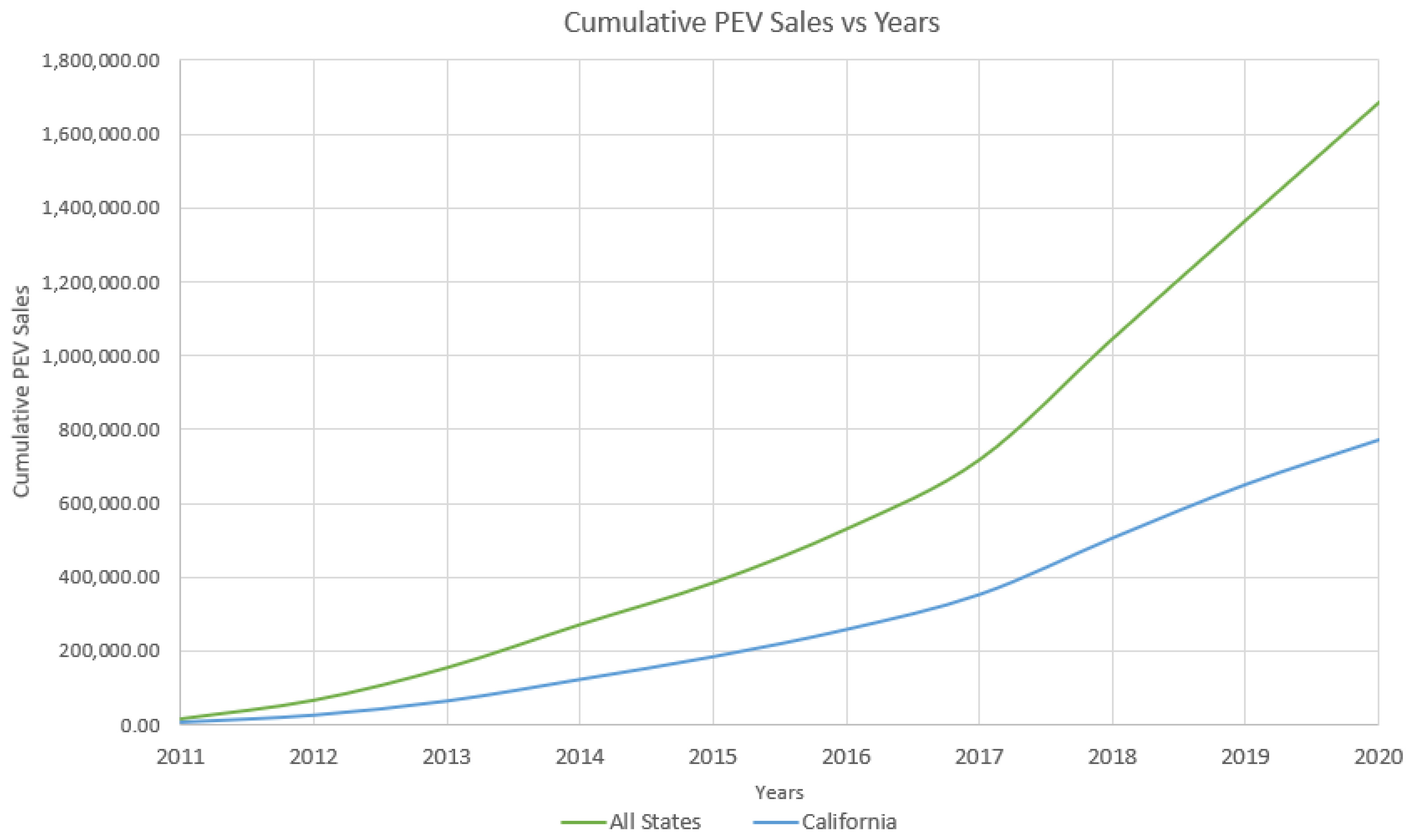
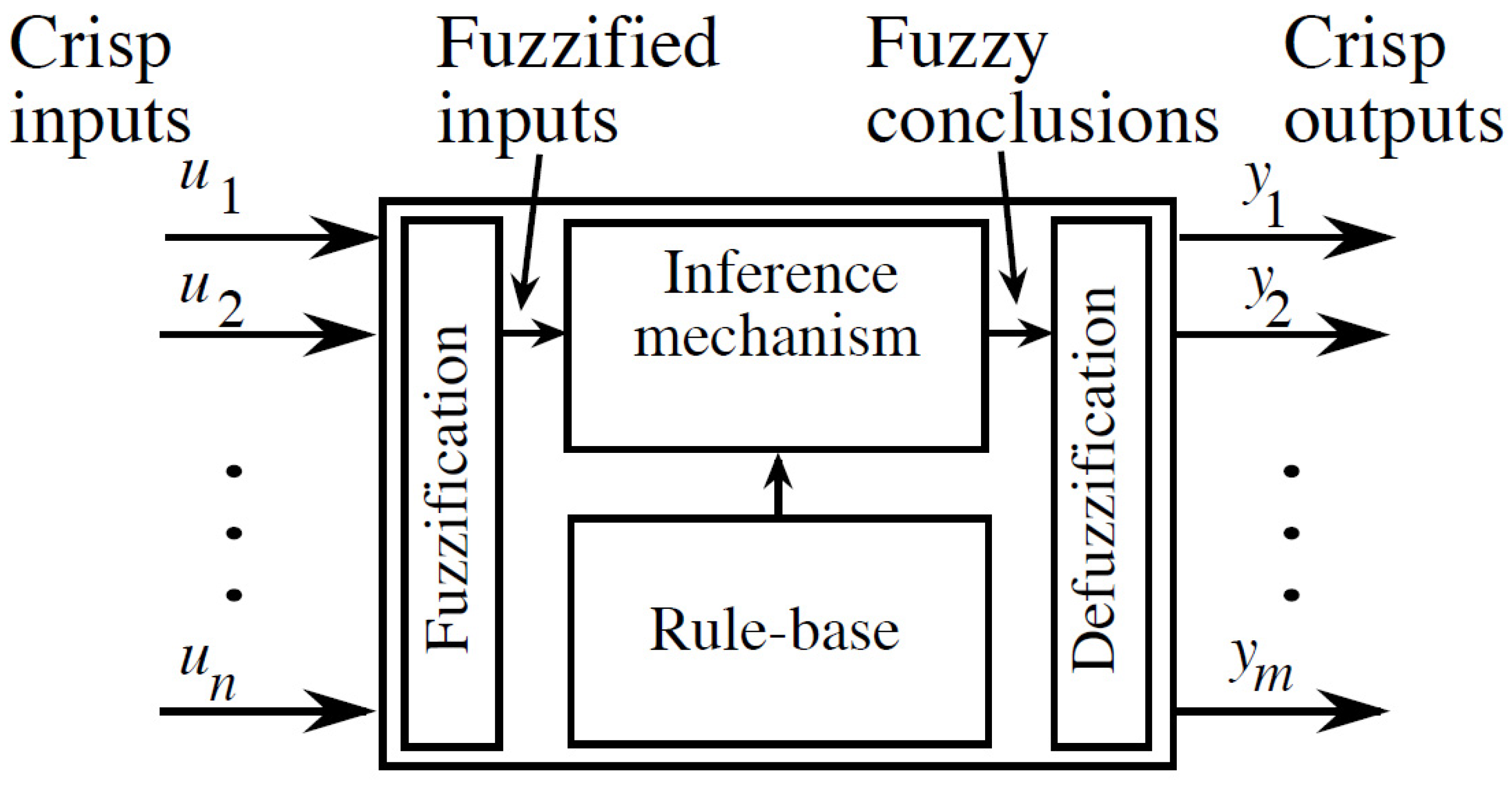
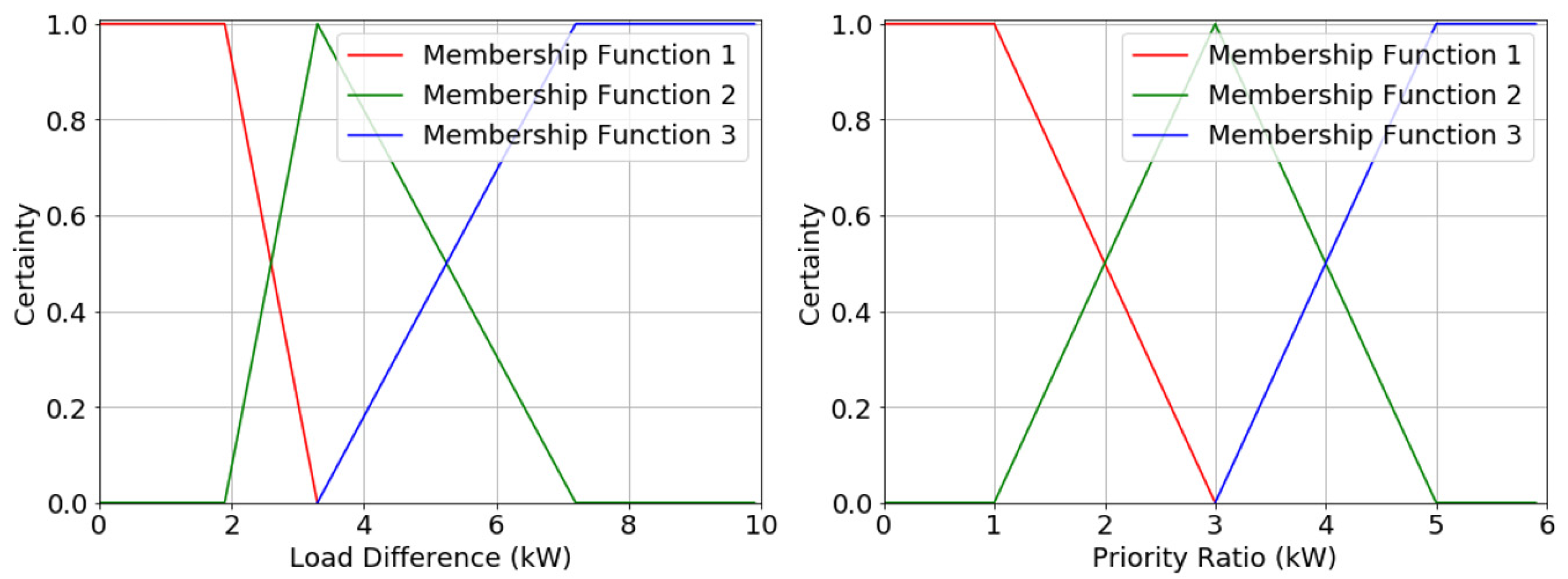
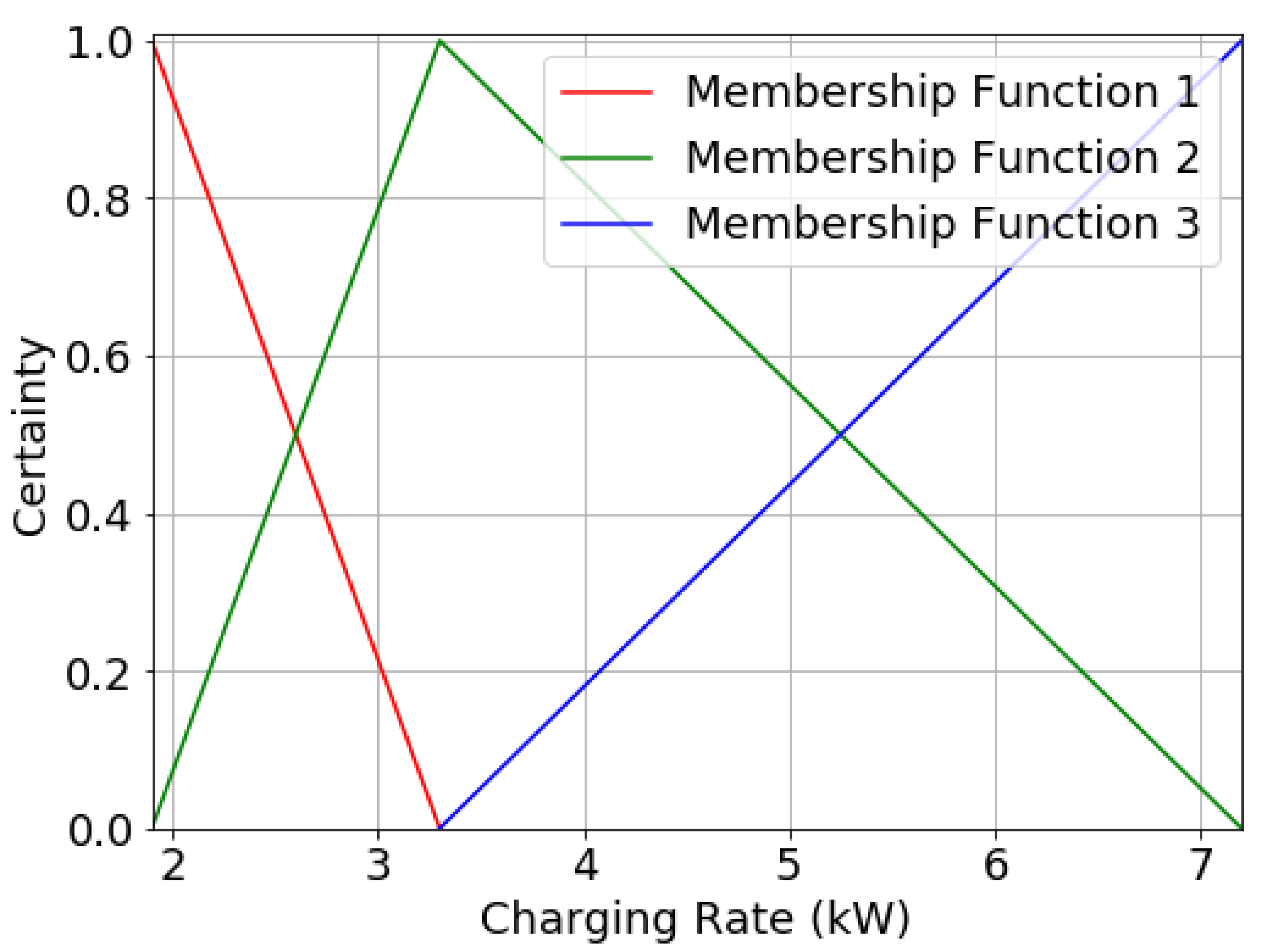

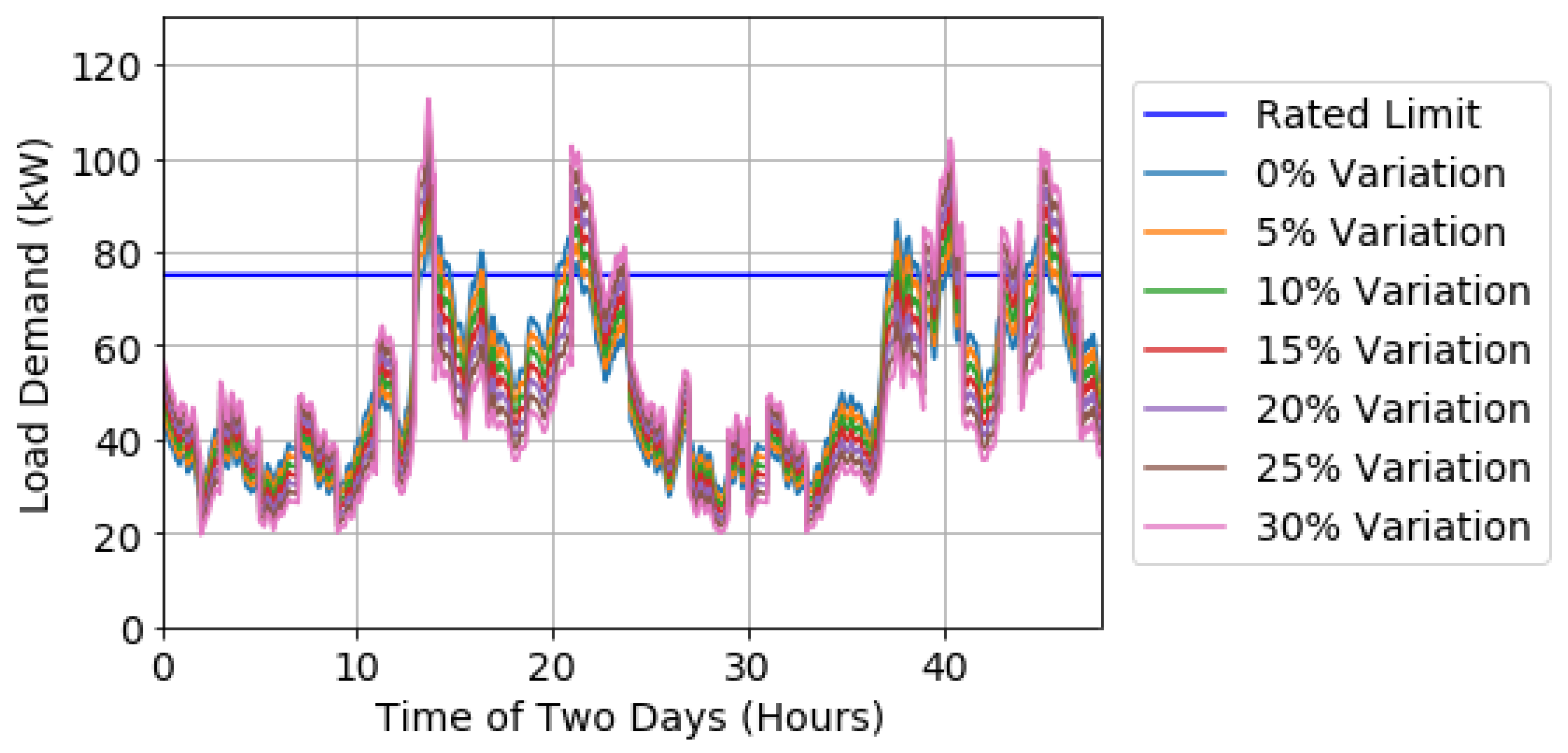

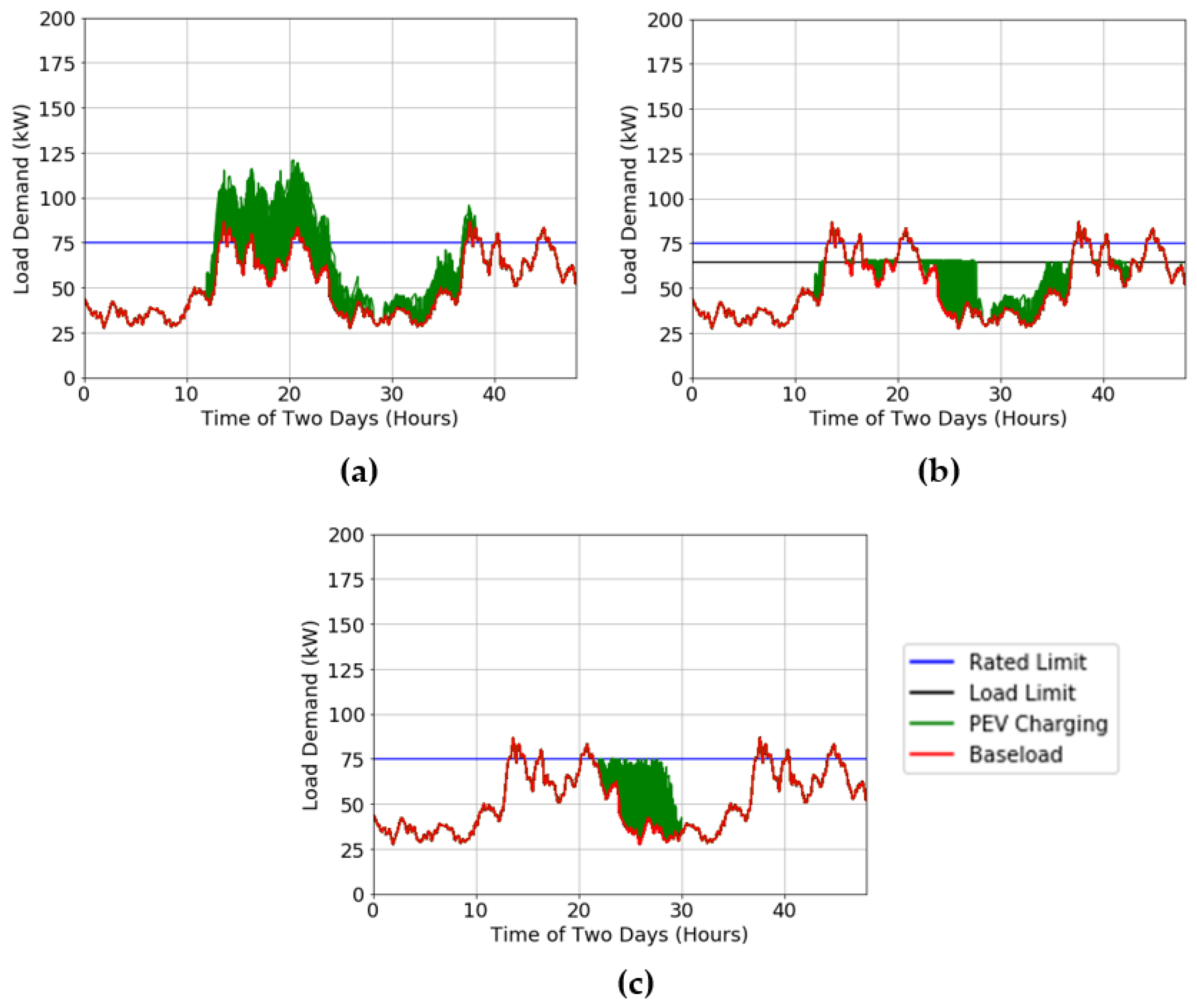
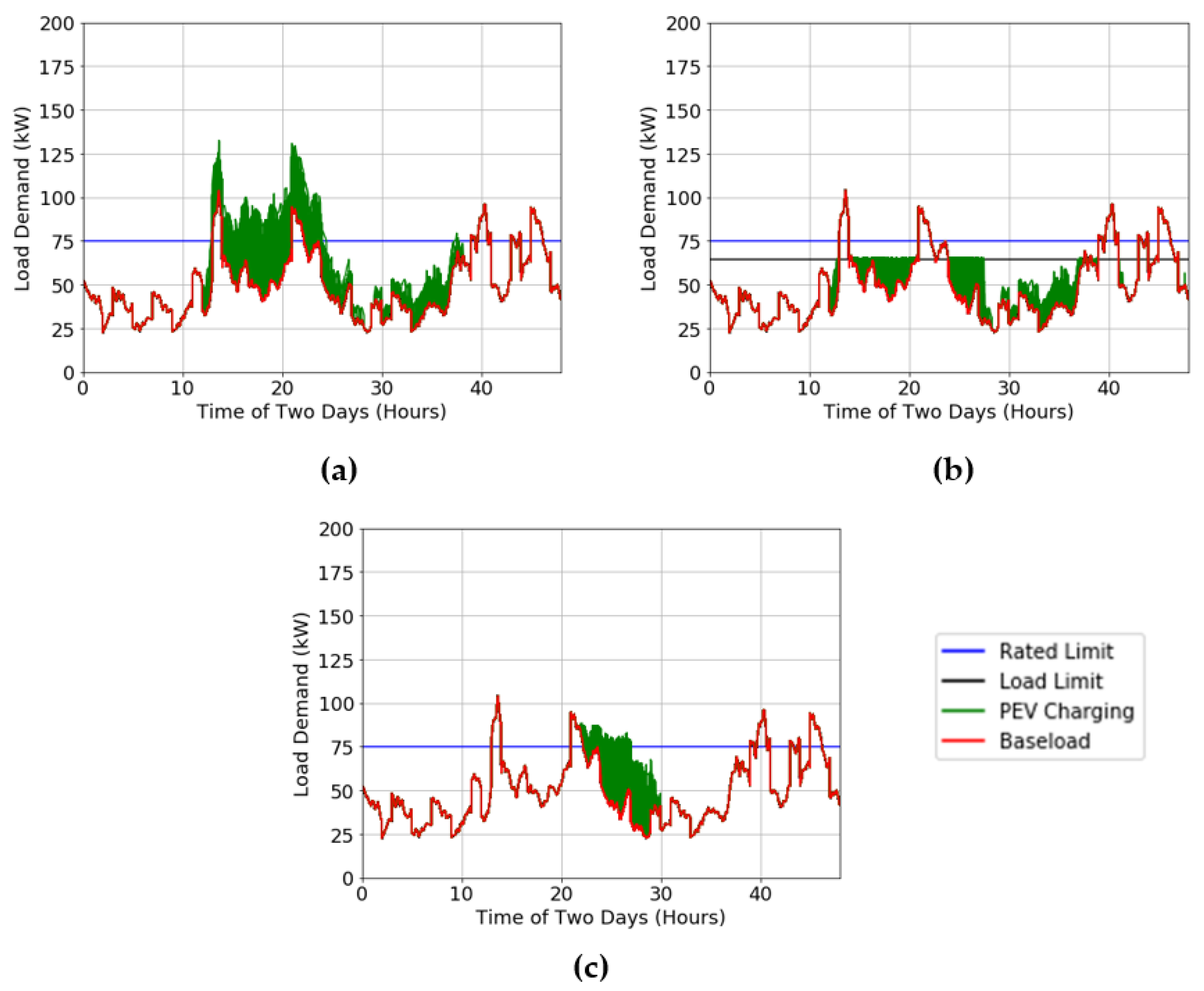

| Charge Rate | Load Difference | |||
|---|---|---|---|---|
| 1 | 2 | 3 | ||
| Priority Ratio | 1 | 1 | 2 | 3 |
| 2 | 2 | 3 | 3 | |
| 3 | 2 | 3 | 3 | |
| Case | 0–40% | 40–50% | 50–60% | 60–70% | 70–80% | 80–90% | 90–100% |
|---|---|---|---|---|---|---|---|
| Uncontrolled | 0 | 0 | 0 | 0 | 0 | 0 | 20,295 |
| 1 | 0 | 0 | 0 | 0 | 0 | 0 | 20,295 |
| 2 | 76 | 51 | 56 | 64 | 51 | 57 | 19,940 |
| 3 | 0 | 0 | 0 | 0 | 0 | 1 | 20,294 |
| 4 | 0 | 0 | 0 | 0 | 0 | 0 | 20,295 |
| 5 | 0 | 0 | 0 | 0 | 0 | 0 | 20,295 |
| 6 | 0 | 0 | 0 | 0 | 0 | 0 | 20,295 |
| 7 | 0 | 0 | 0 | 0 | 0 | 0 | 20,295 |
| Case | Average Load during Charging | Average Load during Charging Percent Difference |
|---|---|---|
| Uncontrolled | 74.36 | - |
| 1 | 47.54 | 36.07% |
| 2 | 50.62 | 31.93% |
| 3 | 58.35 | 21.53% |
| 4 | 63.16 | 16.53% |
| 5 | 65.75 | 12.29% |
| 6 | 71.09 | 4.50% |
| 7 | 74.03 | 0.44% |
| Profile | Variation Percentage | Absolute Maximum Peak | Average Maximum Peak | Average Load during Charging | Absolute Maximum Peak Percent Difference | Average Maximum Peak Percent Difference | Average Load during Charging Percent Difference |
|---|---|---|---|---|---|---|---|
| Uncontrolled | 0 | 120.82 | 97.87 | 74.53 | - | - | - |
| ARVF | 86.58 | 86.58 | 63.16 | 33.01832 | 12.2418 | 16.51536 | |
| MTR | 86.58 | 86.58 | 54.81 | 33.01832 | 12.2418 | 30.49327 | |
| Uncontrolled | 5 | 119.57 | 97.85 | 73.18 | - | - | - |
| ARVF | 90.91 | 90.91 | 62.89 | 27.23299 | 7.353253 | 15.12457 | |
| MTR | 90.91 | 90.91 | 55.86 | 27.23299 | 7.353253 | 26.84439 | |
| Uncontrolled | 10 | 123.89 | 101.03 | 71.81 | - | - | - |
| ARVF | 95.24 | 95.24 | 61.98 | 26.14886 | 5.900036 | 14.69467 | |
| MTR | 95.24 | 95.24 | 56.91 | 26.14886 | 5.900036 | 23.15103 | |
| Uncontrolled | 15 | 128.22 | 105.10 | 70.47 | - | - | - |
| ARVF | 99.57 | 99.57 | 60.89 | 25.15475 | 5.403821 | 14.58587 | |
| MTR | 99.57 | 99.57 | 57.97 | 25.15475 | 5.403821 | 19.46434 | |
| Uncontrolled | 20 | 132.54 | 109.28 | 69.12 | - | - | - |
| ARVF | 103.90 | 103.90 | 59.84 | 24.22602 | 5.047378 | 14.39206 | |
| MTR | 103.90 | 103.90 | 59.02 | 24.22602 | 5.047378 | 15.76401 | |
| Uncontrolled | 25 | 136.86 | 113.47 | 67.77 | - | - | - |
| ARVF | 108.23 | 108.23 | 58.45 | 23.36285 | 4.727109 | 14.76787 | |
| MTR | 108.23 | 108.23 | 60.07 | 23.36285 | 4.727109 | 12.04631 | |
| Uncontrolled | 30 | 141.18 | 117.67 | 66.42 | - | - | - |
| ARVF | 112.56 | 112.56 | 56.68 | 22.55852 | 4.439039 | 15.82453 | |
| MTR | 112.56 | 112.56 | 61.12 | 22.55852 | 4.439039 | 8.311118 |
Publisher’s Note: MDPI stays neutral with regard to jurisdictional claims in published maps and institutional affiliations. |
© 2021 by the authors. Licensee MDPI, Basel, Switzerland. This article is an open access article distributed under the terms and conditions of the Creative Commons Attribution (CC BY) license (https://creativecommons.org/licenses/by/4.0/).
Share and Cite
Smith, T.; Garcia, J.; Washington, G. Smart Electric Vehicle Charging via Adjustable Real-Time Charging Rates. Appl. Sci. 2021, 11, 10962. https://doi.org/10.3390/app112210962
Smith T, Garcia J, Washington G. Smart Electric Vehicle Charging via Adjustable Real-Time Charging Rates. Applied Sciences. 2021; 11(22):10962. https://doi.org/10.3390/app112210962
Chicago/Turabian StyleSmith, Theron, Joseph Garcia, and Gregory Washington. 2021. "Smart Electric Vehicle Charging via Adjustable Real-Time Charging Rates" Applied Sciences 11, no. 22: 10962. https://doi.org/10.3390/app112210962






